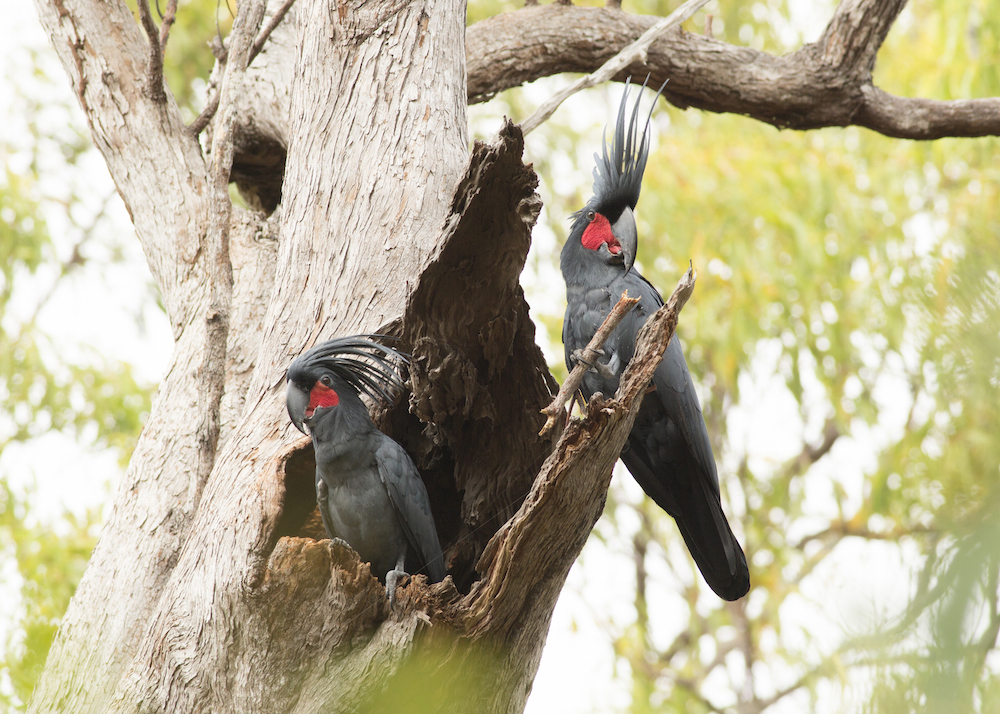Cockatoos Drop Sick Beats to Charm Mates
That's because the percussionist isn't a human, but a bird: the palm cockatoo (Probosciger aterrimus) of Australia and New Guinea. The cockatoo is the only nonhuman animal on record to rhythmically drum with a customized "sound tool," but its reason for drumming isn't so different from that of many human musicians: These feathered Romeos are looking for love, the researchers found.
During courtship, male cockatoos search for drumsticks, sometimes breaking a sturdy branch off a tree and trimming it down to about 8 inches (20 centimeters) in length. Then, the cockatoos rhythmically strike the tool against their nesting tree, wooing potential mates with a steady beat, the researchers said. [Image Gallery: A Crafty Cockatoo Uses Tools]
"The female watches the male very closely, including the tool manufacture part, which demonstrates the power of the male's beak when he snips off the branch," said study lead researcher Robert Heinsohn, a professor in the Fenner School of Environment and Society at Australian National University.
Drumming solo
Heinsohn first came across the drumming cockatoos while studying a different parrot species on Cape York Peninsula in North Queensland, Australia, in 1997.
"I was walking through the rainforest and heard a clear tapping sound ahead," Heinsohn told Live Science in an email. "It was a beautiful male palm cockatoo striking the edge of a hollow in the tree trunk with a stick. I have never been so mesmerized by anything in nature, and swore that one day I would undertake the research necessary to understand why they do this."
Fulfilling that promise took seven years, as Heinsohn and his colleagues stealthily recorded video of the cockatoos before egg-laying season began in June and July (winter in the Southern Hemisphere). Before the researchers' study, a brief note in a 1984 bird journal was the only description of the cockatoos' rhythmic behavior, Heinsohn said.

After collecting 131 recordings from 18 male cockatoos, the researchers used computer software to convert the recordings into spectrograms (visual displays of sound). Statistician consultations showed "beyond any doubt that these birds are rhythmic," meaning that the beats weren't random, but rather were equally spaced apart, Heinsohn said.
Sign up for the Live Science daily newsletter now
Get the world’s most fascinating discoveries delivered straight to your inbox.
Moreover, the statistical analysis showed that each of the 18 birds had its own distinct style. Some beats were faster and others were slower, and "interestingly, some males had a fast flourish of beats when they started and then slowed down to a steady beat," Heinsohn said.
These findings show that cockatoos share several key components seen in human instrumental music, including making a sound tool (the drumstick), performing in a consistent context (in this case, mating), making regular beats and creating individualistic styles, the researchers said in the study.
Other animals are known to drum, too, including rodents that stomp their feet, woodpeckers that peck, and chimps that drum their hands and feet on tree stumps. But none of these percussive sounds are rhythmic, nor do these animals make a special sound tool, Heinsohn said.
Mating scene
There's a reason why male palm cockatoos put on a spectacular show: Female palm cockatoos lay just one egg once every two years. [Pretty Bird: Images of a Clever Parrot]
During courtship, males try to attract females using different calls (screeches or whistles), movements (head bobbing or wing raising) and blushing to show they're sexually excited, Heinsohn said.
"The drumming and rhythm seems to be an extra component designed to impress the females further," he said, noting that not all males drum. However, those that do tend to put on a solo act — there aren't any "drum circles" in the cockatoo world, Heinsohn said.

These avian drumming acts, some lasting up to 30 minutes, may shed light on how humans began producing rhythms, the scientists said. Perhaps drumming began as a sexual display among humans before it was used for other purposes, such as for interacting with large groups, the researchers said.
But there is one glaring difference between cockatoo and human percussive rhythm: While many humans dance to drum beats, there is no evidence that wild palm cockatoos do, the researchers said.
The study was published online today (June 28) in the journal Science Advances.
Original article on Live Science.

Laura is the archaeology and Life's Little Mysteries editor at Live Science. She also reports on general science, including paleontology. Her work has appeared in The New York Times, Scholastic, Popular Science and Spectrum, a site on autism research. She has won multiple awards from the Society of Professional Journalists and the Washington Newspaper Publishers Association for her reporting at a weekly newspaper near Seattle. Laura holds a bachelor's degree in English literature and psychology from Washington University in St. Louis and a master's degree in science writing from NYU.









